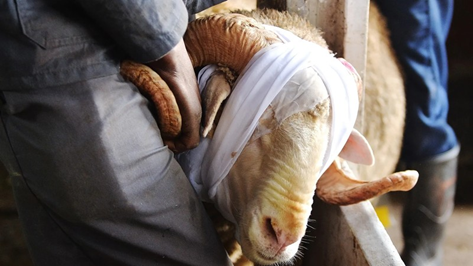The Islamic Calendar is marked by two major holidays, Eid-al-Fitr and Eid-al-Adha. The former occurs at the end of Ramadhan and the latter occurs after Eid-al-Fitr. On Eid-Al-Adha also known as Bakri-Eid, Muslims commemorate the sacrifice of Abraham (Ala-hi-salaam) by slaughtering livestock such as sheep, goats, cows or even camels.
On November 20, 1912, the “Cape Times” reported: “There, in the valley between the mountains of Arafat takes place the feast of the sacrifice, where many thousands of Moslems congregate from all parts of the world, and therefore proceed to Mina, where in fulfilment of the Fifth Commandment, they offer a living sacrifice of either a sheep, goat or camel, as their means allow. “This ceremony is also carried out in the distant part of the world where Mohammedans reside. In Cape Town, Imam Mahmud Effendi, Professor of the Imperial Arabic School, made sacrifice of several sheep, the flesh of which was distributed among the poor of his Parish. “The ceremony was fully observed in the Moslem churches in Cape Town and elsewhere, and special prayers were offered by Imam Mahmud Effendi, who was in attendance, and a moulet was made and conducted by the Imam Abdul Wajgie. (IOL)
The bases of Eid-al-Adha is formed around the sacrifice of a ram by Ibrahim (a.s.) in the place of his son. The slaughter of the animal in question, is supposed to represent the slaughter of one’s own personal demons or ego. The meat from the slaughtered livestock is distributed amongst one’s family, loved ones and even the poor and the needy. The sacrifice is carried out in any part of the world. Arafat is the place where Allah (Subhanu Wa Ta Ala) commanded Ibrahim (A.S.) to sacrifice his son Ismail (AS) but sent a ram in the son’s stead. The commemoration of Eid-al-Adha at the time of the Hajj is meant to honour the sacrifice made by Ibrahim (AS). The practice is one that goes back hundreds of years to the time of Prophet Muhammad (SAW). The faithful gather to read a special naamaz (prayer) in the morning and listen to the Khutba (speech) before that.
Eid al-Adha, the “Festival of Sacrifice”, is one of the most significant Islamic festivals celebrated by Muslims across the world. In South Africa, the event is marked by unique cultural practices and traditions, particularly within the Cape Muslim community. The community has a rich history, including connections to the Ottoman Empire that have influenced its development over the centuries. The festival commemorates the willingness of Prophet Ibrahim (Abraham) to sacrifice his son as an act of obedience to God, a story that resonates deeply with Muslims globally. In South Africa, the day begins with special prayers at Mosques, followed by the ritual sacrifice of animals, usually sheep or cattle. The act symbolizes Ibrahim’s devotion and God’s mercy. The meat from the sacrifice is distributed among family, friends and the less fortunate, ensuring that everyone can partake in the feast.(IOL)
The Cape Malay Muslim Community being based in the Western Cape is at the heart of the cross-roads between two Oceans. The community is a major centre of heritage and tradition, for the Muslim people of South Africa. The sacrifice of the ram by Ibrahim (as) was the bases for sacrificing sheep and other forms of livestock on this day to, show a desire to sacrifice one’s attachment to materialism and personal pride. There are strong connections in terms of Islamic heritage between the former Ottoman Caliphate Sultanate and the Islamic communities and nations across the world. The revolt in Turkey by the Young Turks in 1908 broke with that heritage and tradition. However, there are some roots that hold strong. The continued slaughter and distribution of the meat amongst the poor shows that everyone benefits. Eid is a binding religious obligation that all Muslims must participate in. It will continue for generations.
Article written by:
Thabile Duma
Journalist at Radio Al Ansaar


